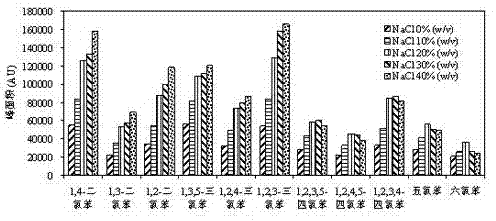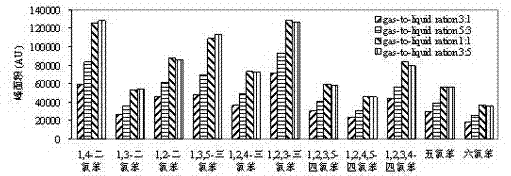Method for catching and detecting static headspace gas chromatography electrons of eleven chlorobenzene compounds in water
A headspace gas chromatography, electron capture detection technology, applied in the direction of measuring devices, instruments, scientific instruments, etc., can solve the problems of 1,2-dichlorobenzene, 1,4-dichlorobenzene, 1,2,4-trichlorobenzene Determination of chlorobenzene, 1,2-dichlorobenzene, 1,3-dichlorobenzene, 1,4-dichlorobenzene, 1,2,4-trichlorobenzene by headspace gas chromatography electron capture detection method reported by chlorobenzene and Han Changmian et al. Chlorine and other problems, to achieve the effect of accurate results, high degree of automation, and simple operation
- Summary
- Abstract
- Description
- Claims
- Application Information
AI Technical Summary
Problems solved by technology
Method used
Image
Examples
Embodiment 1
[0032] Example 1: Determination of 11 kinds of chlorobenzene compounds in Wahaha purified water
[0033] (1) Sampling: Measure 10.00 mL of Wahaha purified water or 10.00 mL of spiked Wahaha purified water containing a certain amount of chlorobenzene compounds (see Table 2 for the content of chlorobenzene compounds) in a 20 mL headspace bottle, and make The gas-liquid volume ratio in the headspace bottle is 1:1, add 2.00 g of sodium chloride, and immediately use the headspace bottle mouth sealer to cover the bottle mouth of the headspace bottle with an aluminum cap with a silicone pad coated with a polytetrafluoroethylene film inside. Seal it; vortex with a vortex shaker to dissolve sodium chloride so that the concentration of added sodium chloride is 20% (v / w), and place the sample on a 32-position headspace sampler.
[0034] (2) Setup and operation of the static headspace sampling program: the static headspace sampling conditions were an equilibrium temperature of 70°C, an eq...
Embodiment 2
[0038] Embodiment 2: the mensuration of 11 kinds of chlorobenzene compounds in laboratory tap water
[0039] (1) Sampling: Measure 10.00 mL of laboratory tap water or 10.00 mL of spiked laboratory tap water containing a certain amount of chlorobenzene compounds (see Table 2 for the content of chlorobenzene compounds) in a 20 mL headspace bottle, and make The gas-liquid volume ratio in the headspace bottle is 1:1, add 2.00 g of sodium chloride, and immediately use the headspace bottle mouth sealer to cover the bottle mouth of the headspace bottle with an aluminum cap with a silicone pad coated with a polytetrafluoroethylene film inside. Seal it; vortex with a vortex shaker to dissolve sodium chloride so that the concentration of added sodium chloride is 20% (v / w), and place the sample on a 32-position headspace sampler.
[0040] (2) Setup and operation of the static headspace sampling program: the static headspace sampling conditions were an equilibrium temperature of 70°C, an ...
Embodiment 3
[0044] Embodiment 3: Determination of 11 kinds of chlorobenzene compounds in seawater of Zhoushan sea area
[0045] (1) Sampling: Measure 10.00 mL of seawater from Zhoushan sea area or 10.00 mL of spiked seawater from Zhoushan sea area containing a certain amount of chlorobenzene compounds (see Table 2 for the content of chlorobenzene compounds) in a 20 mL headspace bottle. The gas-liquid volume ratio in the headspace bottle is 1:1, add 2.00 g of sodium chloride, and immediately use the headspace bottle mouth sealer to cover the bottle mouth of the headspace bottle with an aluminum cap with a silicone pad coated with a polytetrafluoroethylene film inside. Seal it; vortex with a vortex shaker to dissolve sodium chloride so that the concentration of added sodium chloride is 20% (v / w), and place the sample on a 32-position headspace sampler.
[0046] (2) Setup and operation of the static headspace sampling program: the static headspace sampling conditions were an equilibrium temp...
PUM
 Login to View More
Login to View More Abstract
Description
Claims
Application Information
 Login to View More
Login to View More - R&D
- Intellectual Property
- Life Sciences
- Materials
- Tech Scout
- Unparalleled Data Quality
- Higher Quality Content
- 60% Fewer Hallucinations
Browse by: Latest US Patents, China's latest patents, Technical Efficacy Thesaurus, Application Domain, Technology Topic, Popular Technical Reports.
© 2025 PatSnap. All rights reserved.Legal|Privacy policy|Modern Slavery Act Transparency Statement|Sitemap|About US| Contact US: help@patsnap.com



